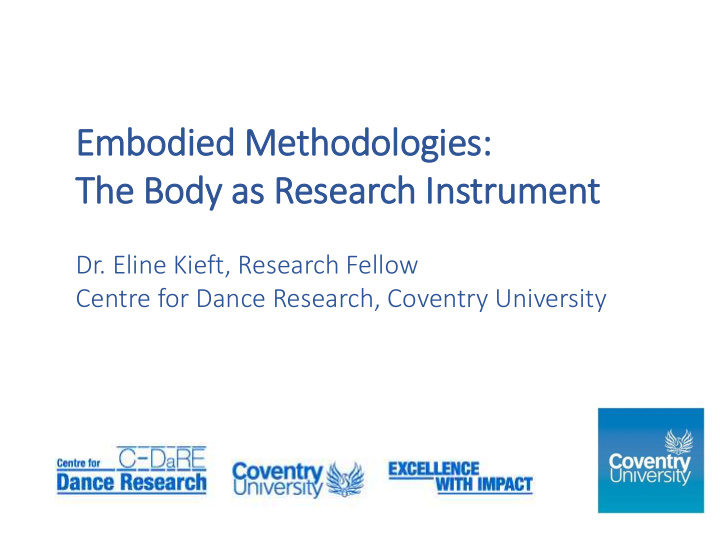



Embodied Methodologies: The Body as Research In Instrument Dr. Eline Kieft, Research Fellow Centre for Dance Research, Coventry University
Three videos on Embodied Methodologies Video 1 Somatic Introduction and Knowing with the Body Video 2 Movement Exploration of Lines and Angles Video 3 The body as research instrument in your research cycle
Benefits of Body as Research Tool of Body as Research Tool Bodily Physical Emotional knowing engagement support Creative Visceral avenue into Outlet, understanding various Release, of data research Reflection phases Getting Management Richer unstuck & of challenging outputs Finding flow emotions
Development of Somatics (from Greek, sōma : ‘body’) 1. End 19 th century: breaking free from Victorian limitations, often in response to illness, disabilities, and possible through exposure to ‘exotic’ practice (Eddy, 2009) 2. Phenomenological/existential theorists (Dewey, Merleau-Ponty, and Whitehead) 3. Expressionist dance (Mary Wigman, Rudolf von Laban, Kurt Jooss, Ruth St. Denis, Martha Graham) 4. Mid 1980s commonalities between various approaches started to be recognised (Reed, 2011)
Characteristics of Somatic Practice • Awareness of breath and the senses • Conscious relaxation • Connection between inner/outer; self/world • Active agency, choice and time-space dimensions • Role of memory, images and imagination • Exploring different points of view and transitions between those • Recognising and investigating habitual movement responses, and exploring new movement possibilities
Related Concepts • felt sense (Gendlin, 1978) • somatic mind (Fleckenstein, 1999) • somatosensory awareness (Fraleigh, 2000) • bodily intelligence (Grau, 1995) • somatic markers (Damasio, 1999) • somaesthetics (Shusterman, 1999)
Other Embodied Scholarship • Embodied Cognition (Chemero, 2009, Clark, 2016, Shapiro, 2011) • Sensory anthropology (Classen, 1997, Grau, 2012, Pink, 2015) • Autoethnography (Buzard, 2003, Ellis, 2004, Anderson, 2006, Strathern, 1987) • Dance Studies (Fraleigh, 2004, Sheets- Johnston 2011) • Sensual Scholarship (Stoller, 1997) • Embodied Research & E/Inquiry (Todres, 2007, Spatz, 2015, Snowber, 2016)
Tacit or Explicit knowledge? Explicit (know that): ➢ Codified knowledge found in documents, databases ➢ Factual, structured ➢ Favoured by educational system Tacit (know-how): ➢ Intuitive, rooted in context & experience ➢ Hard to communicate as it resides in the mind of the knower ➢ Learned through socialisation ➢ Not well handled by IT
Multiple In Intelligences (Gardner, 1983) 1. Logico-Mathematical 2. Linguistic 3. Musical 4. Spatial 5. Bodily-Kinesthetic 6. Intrapersonal 7. Interpersonal
Embodied Perception • Exteroception: outside world • Proprioception: bodily movement and orientation • Interoception: internal physical and emotional states (See for example Cameron & Hamilton, 2002, Shusterman, 2008, Henley, 2014)
Preparation for Movement Task 1. Make space to work undisturbed: close the door, switch off your phone, notify housemates if needed 2. Clear some room to move freely (2x2m). 3. If you do this exercise seated, follow the instructions with your upper body and arms. 4. Gather post-it notes or paper, and a pen. 5. Pause the video now until you have organised this.
1. 1. Core Practic ice 2. 2. Ext xtended Practice 3. 3. Podcast series 4. 4. Blo log www.somaticstoolkit.coventry.ac.uk Developed by Eline Kieft, Ben Spatz, Doerte Weig & Guests
Core Practice 1. Body Basics: Arriving PRE-FIELDWORK 2. Literature: A Spatial Approach Preparation 3. Identity: Noticing Your Lenses 4. Confidence: Taking on the Researcher’s Mantel FIELDWORK 5. Observation: Seeing and Being Seen Data 6. Interviews: Intimacy and Reciprocity in the Field Collection 7. Places: Being in the Unknown POST-FIELDWORK 8. Analysis: Moving with Polarities Analysis & 9. Writing: Embodying your Thoughts Dissemination 10. Presenting: A full-bodied Performance
Ext xtended Practice Developed by Guests Urban Environment Discomfort Fatigue Gender Gaze Ethics Ecology Butoh Camera Overwhelm Rest & Restoration Blood
http://somaticstoolkit.coventry.ac.uk/ extended-practice-dealing-with-challenging-research-situations/
To Explore through and with Body • Place • People • Research Aspects • Analytical concepts • Emotions
1. 1. Core Practic ice 2. 2. Ext xtended Practice 3. 3. Podcast series 4. 4. Blo log www.somaticstoolkit.coventry.ac.uk Developed by Eline Kieft, Ben Spatz, Doerte Weig & Guests
For more information visit: http://somaticstoolkit.coventry.ac.uk
Recommend
More recommend